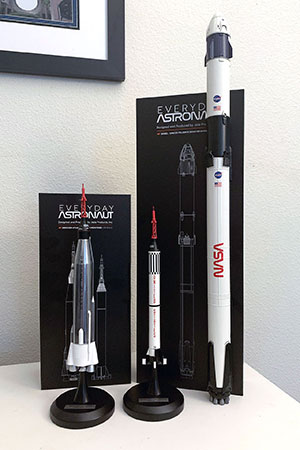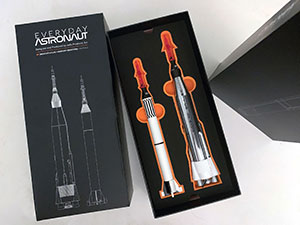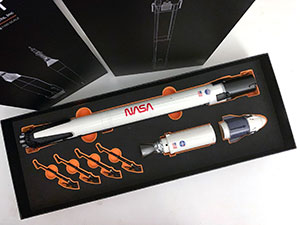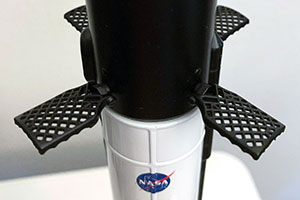July 21, 2025 — Looking at the SpaceX Falcon 9 standing on the launch pad today (July 21), it can be difficult to imagine that the rocket that started U.S. human spaceflight, the Mercury-Redstone, differed so greatly in dimension.
Astronauts who ride atop the modern commercial booster almost have a head start into space even before the engines ignite. To get into their Dragon capsules they have to ascend almost three times the height of the converted missile that lifted off on a suborbital mission for the last time 64 years ago on this day.
Tim Dodd, who goes by the online moniker "Everyday Astronaut," wanted a way to appreciate that span in scale.
"Honestly, it came from the quest of just wanting my own rocket garden," said Dodd in an interview. "And it frustrated me that there wasn't a single source for different rockets. You just had to hodgepodge a collection together."
"So that was the inspiration. If no one else is going to make consistent models of the same scale and quality then why not me?" he said.
That was almost 10 years ago. In June 2022, Dodd launched his first desktop model, a die cast Falcon 9 modeled after SpaceX's rocket that was the first to liftoff with astronauts in 2020 for $375.
Then in May of this year, he began sales of a two-pack with the Mercury-Redstone and orbital Mercury-Atlas boosters that flew the first NASA astronauts into space in the early 1960s for $350.
"Trying to figure out how exactly to do it was a very tedious process. It took over a year to even get to the point where we kind of knew how to do it, and that was with our partners having manufacturing experience," said Dodd. "And then once we got in our first order, 90 percent of them had major paint flaws, like dripping, running and fingerprints. We were a year and a half into it and I was so distraught."
The Falcon 9 was a learning experience. Dodd initially thought the major hurdle was going to be getting the injection mold made, but equally important was quality control. Eventually, he was able to work that out with "a lot of back and forth."
The Mercury set went much smoother, he said.
"I almost forgot about it and the next thing I knew I had the prototype models sitting on my desk and they were great. Six months later, I had the finished manufacturing product and it was beautiful," Dodd told collectSPACE.
Even before opening the boxes, you know the Falcon is going to tower over the Redstone (and the Atlas). The SpaceX rocket is not even assembled inside, and its packaging is 50 percent taller than the Mercury box.
That was what drove Todd to choose 1:100 for the scale.
"If we went any smaller, the Mercury-Redstone would literally be a pencil," he said. "One-one hundredth is really just the sweet spot, since rockets are all over the place in terms of scale to each other. If we really wanted them all to be to the same scale, 1:100th was about the only thing that made any sense."
"Of course, a 1:100 Saturn V [moon rocket] is going to be huge. It is going to have to come in a box the size of a vacuum cleaner," said Dodd.
With size comes details. The Falcon 9's stages separate, its grid fins move and its landing legs can be deployed. The smaller Mercury rockets presented more of a challenge but feature accurate flight markings on their capsules and the Atlas has a polished metal tank.
"The big one that I really wanted with Atlas was I wanted the drop engines, the booster engines, to drop out," Dodd said. "The two outer engines actually do gimbal. They actually intentionally swivel. So that was a cool detail that we were able to have those be movable, and then you can drop the whole skirt section down, just like the boost engines on the Atlas."
Dodd has designs on building out his "rocket garden" with the other U.S. human spaceflight vehicles, as well as the Russian rockets (he really wants to produce a Soviet-era N-1 moon rocket and Russia's answer to the U.S. space shuttle, the Buran). Once those are done, he will move on to other boosters.
Dodd is currently in the early stages of planning a Gemini-Titan and, for his next set, an add-on pack for the Falcon 9.
"A lot of people said they wanted a payload fairing, so we're working on one as well as a strongback," said Dodd, referring to the support structure that stands up the rocket on the launch pad. "I don't know if we have landed on how we're doing this, but also a Falcon Heavy conversion, so that if people want to make their Falcon 9 into a Falcon Heavy they can do that. Or perhaps we will sell the Falcon Heavy as its own set."
Ultimately, Dodd wants the Everyday Astronaut series of scale rockets to enable anyone who wants it, to plant their own rocket garden.
"I want it to look like it could fit into a high end office," he said. "I want it to be clearly not a toy that someone has sitting around, but a shelf piece, something that's like a piece of memorabilia or a trophy, and as that collection grows, it just looks better and better." |
|

The Falcon 9 (at right) towers over the Mercury-Redstone (center) and Mercury-Atlas rockets as 1:100 scale die-cast models sold by Everyday Astronaut. (collectSPACE)

NASA's two Mercury program launch vehicles, the Redstone (left) and Atlas, come as a set from Everyday Astronaut. (collectSPACE)

Everyday Astronaut's 1:100 scale SpaceX Falcon 9 comes with its two stages, the Crew Dragon and leg struts. (collectSPACE)

The grid fins on the first stage of Everyday Astronaut's 1:00 scale Falcon 9 rocket can be deployed and oriented. (collectSPACE) |
